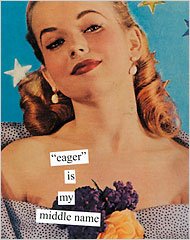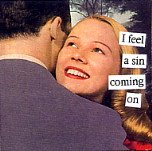 I married my second boyfriend. So when we divorced shortly before my thirtieth birthday, I wasn't exactly an expert in the world of sex and dating.
I married my second boyfriend. So when we divorced shortly before my thirtieth birthday, I wasn't exactly an expert in the world of sex and dating.I'll admit that it was fascinating, fun, and sometimes unnerving to learn how to read the verbal and non-verbal cues that make up the language of seduction. I'll also admit that I was honestly clueless early in the game. Still, it's a good feeling to come into my own at this stage, because my self esteem has never been better.
Through my adventures in dating, I've become a little less naïve, figured out what I do and don't want in a relationship, and am enjoying all aspects of my renaissance. That goes double for the sex.
Still, I wouldn't exactly call myself a libertine — yet.
The Taming of the Slur
STEPHANIE ROSENBLOOM
Published: July 13, 2006
WHISPERS follow her like so many eyes. She is the one who will go home with you, the sure bet, the kind of girl you can lie down with and then walk all over. She is ogled, envied and often ostracized. She is the slut.
The word, which originated in the Middle Ages, has emerged from a schoolyard barb to become commonplace in popular culture, marketing and casual conversation. In his duet with the rapper Eminem, Nate Dogg describes his hunt for “a big old slut” in the single “Shake That.” The ample-bosomed puppet in the Broadway musical “Avenue Q” is called Lucy the Slut.
Novelty shops and Web sites sell Slut lip balm, bubble bath, soap and lotion. A cocktail is known as the Red-Headed Slut. A teenager on MTV’s “Laguna Beach: The Real Orange County” demanded that a rival admit she was a slut. (She did.)
“Slut’’ is tossed around so often and so casually that many teenagers use it affectionately and in jest among their friends, even incorporating it into their instant messenger screen names.
Like “queer” and “pimp” before it, the word slut seems to be moving away from its meaning as a slur. Or is it?
“It’s definitely a term of familiarity with teens,” said Karell Roxas, a senior editor at Gurl.com, a Web site that addresses issues that affect teenagers. “They’ll say ‘Hi, slut!’ the way my generation would say ‘Hi, chick!’ or ‘Hi, dawg!’ ”

Even among adults, the word is used to demonstrate voraciousness: “coffee slut,” “TV slut.”
“Today, ‘slut,’ even ‘ho’ — girls use it in a fun way, a positive way,” said Atoosa Rubenstein, the editor in chief of Seventeen magazine, adding that a phrase such as “you little slut” has become a way for girlfriends to bust each other’s chops.
Beyond the word itself, cultivating an exhibitionistic, slutty appearance — donning the trappings of promiscuity as opposed to actually being promiscuous — has been a growing influence on fashion and popular culture for a decade.
Women wear T-shirts with provocative slogans. Stripping and pole dancing is an au courant way to exercise. Paris Hilton is called an “American cultural icon” on Sephora.com, where she sells $49 perfume.
Ariel Levy, the author of “Female Chauvinist Pigs: Women and the Rise of Raunch Culture,” said a girl in California told her that she and her friends compete to see who can look “the skankiest.” Ms. Levy told the girl that when she was in high school, girls wanted to be known as “the prettiest” or “the most popular.”
“How did you get the guys?,” the girl replied. “Charm?”
Given all of the slut-posturing, one may be inclined to think that society’s attitudes about women and promiscuity have changed. But it’s not entirely so, say authors who have studied popular culture. An entrenched sexual double standard is not easily uprooted. A promiscuous single man is lauded for being a player or a stud, but a woman who sleeps around rarely is.
Still, “slut’’ stings much more for girls than for women. Teenage girls get the cultural message that they should look provocative. Their social circles are small, so everyone knows who is doing what with whom. And those who do acquire the slut label have to face up to it daily in school and endure snickers about the very thing girls at that age are most embarrassed about — their sexuality.
“All of our pop icons look like porn stars,” Ms. Rubenstein said. “However they’re all virgins, quote unquote,” she said, referring to Jessica Simpson and Britney Spears. “That’s a very complex message to send to girls.”
For junior high and high school girls, said Leora Tanenbaum, the author of “Slut! Growing Up Female with a Bad Reputation,” being labeled a slut is still painful and humiliating, despite pop culture’s semi-embrace of the term. Ms. Roxas of Gurl.com said teenagers often inquire about it.
They ask, Ms. Roxas said, questions like: “I’ve acquired the reputation of being a slut, how do I get around it?” or “If I have a boyfriend and I perform a certain action, does that make me a slut?” (Ms. Levy said that even the girl who competed to dress “the skankiest” made it clear that having sex with someone who is not a boyfriend is unacceptable behavior.)
A slut, according to the primary definition in the Oxford English Dictionary, is “a woman of dirty, slovenly, or untidy habits or appearance; a foul slattern.” The second entry defines a slut as “a woman of a low or loose character; a bold or impudent girl; a hussy, jade.” For decades, the second definition has reigned.
Ms. Tanenbaum, who interviewed more than 100 women between the ages of 14 and 66 who had been pigeonholed as sluts, found that the label can be a self-fulfilling prophecy, leading to greater promiscuity. But, she said, it can also act as a brake, leading a woman to shut down sexually. As for the liberal use of the word today, “It’s still too hurtful,” she said.
There is no way to know if more women are being saddled with the dubious distinction now than in the past. What seems to be true, at least anecdotally, is that it is primarily girls who are pinning the label on other girls. They do it, Ms. Tanenbaum said, because of their confusion over the contradictory messages they receive about their sexuality and how to conduct themselves.
“The way they deal with their anxiety is pointing their fingers at other girls,” Ms. Tanenbaum said, adding that more than 90 percent of the people she interviewed were given their slut label by other girls.
Often, she said, the label has nothing to do with sexual behavior. Among teenagers, the word has been attached to girls whose bodies develop more quickly than those of their peers, Ms. Tanenbaum said, as well as to pretty girls, girls who are somehow different, even girls who have been raped.
“Girls wouldn’t feel the need to do this if we had one sexual standard,” she said. “It’s because we have the double standard that this phenomenon occurs.”
Whether they condone promiscuity or not, adults, who have an easier time than teenagers keeping their sex lives private, do not seem to feel as anxious about being labeled sluts. Nor are they as prone to calling others names.
“Once you get into your 20’s and 30’s, you just have better things to do,” said Susan Schulz, the editor in chief of CosmoGirl! magazine. “Everybody has that one friend who’s kind of loose and takes somebody home.”
But as Carrie Bradshaw might type on her laptop: Is there such a thing as going too far any more? Does society allow single women more sexual partners than it once did, before they get a “bad reputation?”
Jamie Breitman, 27, of Manhattan, has a friend she characterizes as promiscuous, a woman who, when they were in a bar in Spain, ended up singing on a stage and eventually making out with the bass player.
“That’s just the way that she is and we just love her for that,” Ms. Breitman said. “It makes her more interesting and fun and she always has good stories.”
Indeed, many women admired the fictional libertine Samantha Jones on “Sex and the City’’ because she had all of those qualities, not to mention confidence and an unapologetic attitude about satisfying her desires. Enjoyment was always mutual.
But viewers often commented that such a woman could not exist in real life. That attitude, Ms. Levy said, “goes to show we can’t accept a woman who’s promiscuous because she wants to be.”
Some men, especially, seem to have strong feelings about the matter.
“When I think of the word slut,” wrote Don Reisinger, a student doing accounting and law work in Albany, in an e-mail message, “I think of a woman who has been around the block more times than my dad’s Chevy. I might date a slut, but I certainly wouldn’t marry one.”
For that reason, perhaps, women sometimes feel pressured to downplay their sexual experience. “Women still have a script for their future that involves marriage, that involves children,” said Dr. Susan Freeman, an assistant professor of women’s studies at Minnesota State University, Mankato. “It governs a lot of choices they make, how sexually active they can be, what risks they are willing to take in terms of alienating a possible marriage partner.”
There seems to be a mysterious line between being experienced and being a slut, and no one can put a number on it. According to a government report released last year (“Sexual Behavior and Selected Health Measures”), men age 30 to 44 have had a median of six to eight sexual partners in their lifetimes. The women’s median was about four.
Many women steer clear of the numbers conversation entirely, but as was pointed out several times in interviews, it would be more unusual for them to be virgins.
The fact is, Ms. Levy said, “I think there are a lot of women who want to have a lot of sex because they enjoy it.”

2 commentaires:
I want credit for the Latter-Day Slut naming. Speaking of which, you need to go to more runs so we can give you that name properly before it slips away to someone else. You should come Monday because I'll be rocking the hash-shit vest thanks to my sumo exploits.
Yes, Trevor is the brains behind the headline. It's not yet my hashing name, as I haven't been to enough runs to be christened. And Mondays are out due to class. I hate it when getting my learn on gets in the way of my fun.
Enregistrer un commentaire